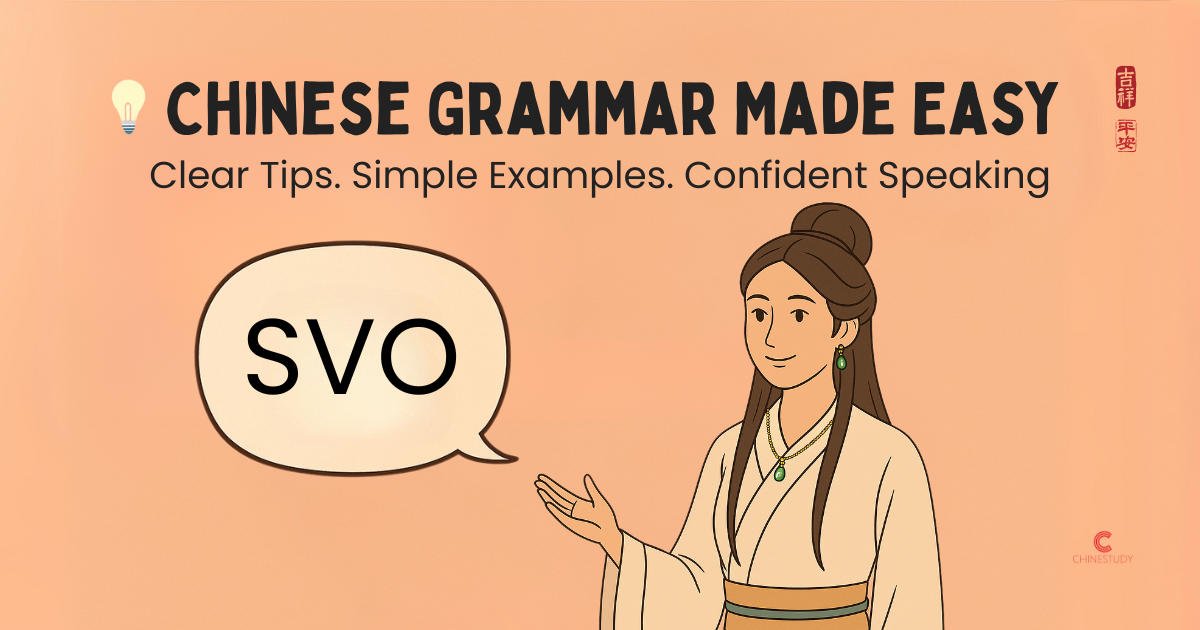|
English |
Chinese |
Pinyin |
|---|---|---|
|
I eat an apple. |
我吃苹果。 |
Wǒ chī píngguǒ. |
📝 How to Build a Chinese Sentence: Subject + Verb + Object

Chinese grammar can feel like a big puzzle… but let’s start with the easiest and most useful part:
👉 The Subject + Verb + Object sentence structure.
If you know this, you can already say a lot in Chinese!
📚 What Is Subject + Verb + Object?
It’s simple.
You just follow this order in a Chinese sentence:
👤 Subject + 🏃 Verb + 🎯 Object
- 我 (wǒ) = I
- 吃 (chī) = eat
- 苹果 (píngguǒ) = apple
See? Very clear.
No need to change the word order like in some other languages.
💡 More Examples
1.
他喝茶。
(Tā hē chá.)
→ He drinks tea.
👉 Let’s break it down:
|
Subject |
Verb |
Object |
|---|---|---|
|
他 |
喝 |
茶 |
|
tā |
hē |
chá |
|
he |
drink |
tea |
2.
他们看电影。
(Tāmen kàn diànyǐng.)
→ They watch a movie.
👉 Let’s break it down:
|
Subject |
Verb |
Object |
|---|---|---|
|
他们 |
看 |
电影 |
|
tāmen |
kàn |
diànyǐng |
|
they |
watch |
movie |
3.
我们学中文。
(Wǒmen xué Zhōngwén.)
→ We learn Chinese.
👉 Let’s break it down:
|
Subject |
Verb |
Object |
|---|---|---|
|
我们 |
学 |
中文 |
|
wǒmen |
xué |
Zhōngwén |
|
we |
learn |
Chinese |
🎯 Practice Time!
👉 Rearrange the words to make a correct Chinese sentence.
1️⃣ 学, 我, 汉语
→ _______________________
2️⃣ 咖啡, 喝, 你
→ _______________________
3️⃣ 书, 她, 看
→ _______________________
✅ Answers:
1️⃣ 我学汉语。
(Wǒ xué Hànyǔ.)
I learn Chinese.
2️⃣ 你喝咖啡。
(Nǐ hē kāfēi.)
You drink coffee.
3️⃣ 她看书。
(Tā kàn shū.)
She reads a book.
💡 Easy Tip to Remember
Chinese keeps things simple and clear.
Just think:
WHO + DO WHAT + TO WHAT.
Subject + Verb + Object. Easy!
🚀 Final Thoughts
This is the foundation of your Chinese grammar.
You’ll use it every day in conversations.
📘 Ready to learn more?
👉 Explore the full blog series: Chinese Grammar Made Easy.
Thank you for subscribing!
Have a great day!